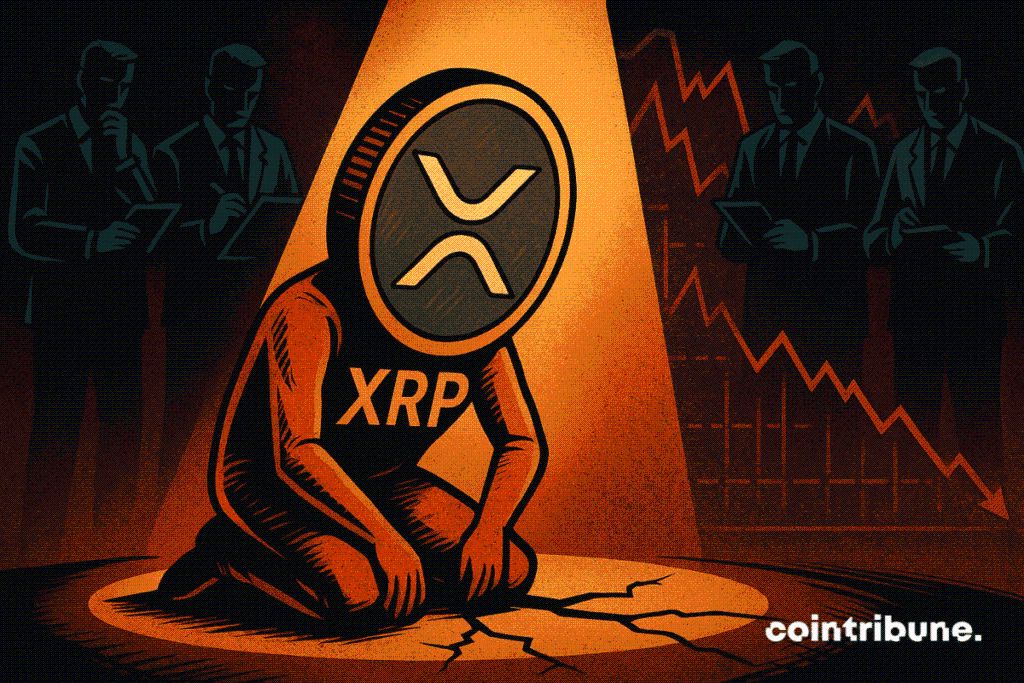41 % Of XRP Holders Underwater Despite High Price
Behind the apparent rise of XRP, the technical signals turn red. While Ripple’s crypto shows a sustained price, the on-chain data reveal a worrying fragility : a large share of recent investors are at a loss, exposing the market to potentially explosive selling pressure.

In brief
- XRP shows a high price (around $2.15), but 41.5 % of the circulating supply is at an unrealized loss.
- Only 58.5 % of tokens are currently in profit, a historically low level since November 2024.
- The majority of holders at a loss are recent investors who entered during speculative rally phases.
- If the current support breaks, the price could plunge towards the $1.70–$1.80 area, according to analysts.
A majority of investors at a loss
While the price did not explode after the ETF launch , only 58.5 % of XRP’s circulating supply is currently in profit according to the latest data published by Glassnode, marking an unprecedented low since November 2024.
At that time, the crypto was trading around $0.53, far from the current $2.15. This paradox reveals an atypical situation. Despite a price nearly four times higher, 41.5 % of XRP in circulation (around 26.5 billion tokens) are held at a loss.
This uneven distribution reveals a critical structural problem, in a market where the majority of buyers arrived late, often during rally phases.
This phenomenon reflects the presence of an “upwardly unbalanced” market, dominated by investors who bought at too high levels. Thus, these investors, now at an unrealized loss, are particularly vulnerable to price drops. Moreover, this imbalance increases the risk of massive selling, especially during panic phases. The following elements help to better understand the current fragility of XRP :
- A large part of the supply is at a loss despite a high price : 41.5 % of circulating tokens, about 26.5 billion XRP ;
- Recent buyers highly exposed : those who entered after the ETF announcement or during the recent bullish impulse are now the most affected ;
- A short-term speculative dynamic : the previous rally was fueled by opportunistic flows, not by fundamental signals or sustained adoption ;
- Increased risk of capitulation : historically, such a concentration of losses favors phases of brutal, cascading liquidation if the downward trend intensifies.
At this point, the XRP market no longer rests on solid foundations, but on an unstable structure where the slightest uncertainty can trigger a chain reaction. The growing weight of holders at a loss could become a determining factor in the short-term price evolution.
Fragile technical signals and increased macroeconomic pressure
Alongside this internal pressure on the XRP market, current technical signals confirm an established bearish momentum.
XRP has been trending clearly downward since early October, as the crypto now trades below its 50, 100, and 200-day moving averages. Worse, these curves are bending downwards, which typically indicates deteriorating momentum.
The chart also shows that every rebound attempt since September has failed to break the $2.50 to $2.60 resistance zone. This setup suggests increasing bullish weakness, reinforced by exploding selling volumes during corrections.
Added to this is a macroeconomic context unfavorable to risky assets like XRP. Indeed, global markets are adjusting to increased rate volatility, persistent geopolitical tensions, and a global withdrawal of dollar liquidity. In other words, institutional investors are reducing their exposure to cryptos in an environment perceived as uncertain, even hostile.
The combination of these factors creates a slippery slope. If XRP were to break its current support around $2.15, the next liquidity pocket lies between $1.70 and $1.80, a level aggressively defended by buyers earlier this year.
Despite growing institutional enthusiasm, the XRP price remains trapped in a fragile dynamic, between massive sell-offs and holders at a loss. This imbalance creates uncertainties about the market’s ability to regain a stable trajectory in the coming weeks.